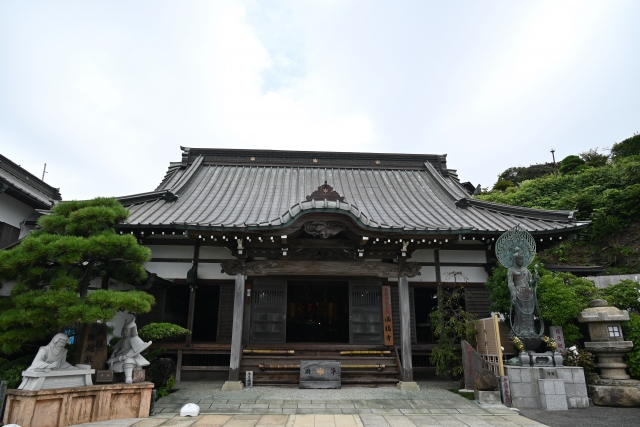About Kamakura Manpukuji Temple
Manpukuji Temple started around the 7th century and the founder was called Gyunggi. The main deity worshipped is Yakushi Nyorai Buddha. It is famous for the fact that Gensokyo was written here in the shape of Oboshi. Waegoshi is the name of the place.
In 1185, after a victory in a battle, Gen Yoshitsune took the prisoners of the Heike family to Kyoto to see Yoritomo, but when he was passing through the place, he was informed by Yoritomo that the prisoners could be handed over and taken to the capital, but Gen Yoshitsune was not allowed to enter the capital. Gen Yoshitsune was deeply concerned about the deterioration of his brother’s relationship, so he wrote the “Ochikoshi Writ” at Manpukuji Temple and passed it to Oe Hirogen, a close friend of Yoritomo.

The “Waikoshi Suit” is similar to Cao Zhi’s seven-step poem, which is about his brother’s love for him and his years of fighting in the battlefield, and asks his brother to forgive his brother for the sake of his father. However, the poem did not impress Yuan Yoritomo, who was determined to get rid of Yuan Yijing.
A few years later, in 1189, Minamoto Yoritomo sent his own father-in-law, Hojo Tokimasa, to lead an army to besiege Minamoto Yoshitsune, whose personal bodyguard, Benkei, was killed in a desperate battle. The head of Minamoto Yoshitsune was cut off and brought to Minamoto Yoritomo in Kamakura, where he was buried in the White Flag Shrine.
How to get there
4-8, Koshigoe 2-chome, Kamakura-shi, Kanagawa 248-0033, Japan
Tips
Manpukuji Temple began around the 7th century and the founder was called Gyunggi. The main deity worshipped is Yakushi Nyorai Buddha. It is famous for the fact that Gensokyo was written here in the shape of Oboshi. Ochikoshi is the name of the place.
Minamoto Yoshitsune is a very famous tragic and heroic figure in Japan. The previous is too long, so let’s talk about it briefly.
Gen Yoshitsune (1159-89) was the youngest son of Gen Yoritomo and his mother was a concubine of Gen Yoritomo, a maidservant, which was probably one of the reasons why Gen Yoritomo did not remember his brother’s love.
After his father’s death, he followed his mother to wander around, and was later pardoned when his mother was taken as a concubine by Hiraki Seimei, but he was also in a difficult situation, which is not discussed here. The two men sat opposite each other by a river (Hwangse River), met in tears, and vowed to destroy the Heike clan and avenge their father’s death.
For several years, Minamoto Yoshitsune fought bravely and wisely for his brother, and was highly successful in battle. This gradually made Minamoto Yoritomo suspicious of him. The relationship between the brothers gradually became estranged, and the relationship also gradually cold talk.
In 1185, after a victory in a battle, Gen Yoshitsune took the Heike prisoners to Kyoto to see Yoritomo, but when he passed through Ochiai, he was informed by Yoritomo that the prisoners could be taken to the capital, but Gen Yoshitsune was not allowed to enter the capital. Gen Yoshitsune was deeply concerned about the bad relationship between his brothers, so he wrote the “Ochikoshi Writing” at Manpukuji Temple and passed it to Oe Hirogen, a close friend of Minamoto Yoritomo.
The “Waikoshi Suit” is similar to Cao Zhi’s seven-step poem, which is about his brother’s love for him and his years of fighting in the battlefield, and asks his brother to forgive his brother for the sake of his father. However, the poem did not impress Yoritomo, who was determined to get rid of Yuan Yijing.
A few years later, in 1189, Minamoto Yoritomo sent his own father-in-law, Hojo Tokimasa, to lead an army to besiege Minamoto Yoshitsune, whose personal bodyguard, Benkei, was killed in a desperate battle. The head of Minamoto Yoshitsune was cut off and brought to Minamoto Yoritomo in Kamakura, and then buried in the White Flag Shrine. The body was buried on the spot (Kurikoma Numakura Magistrate Mori, Kurihara City, Miyagi Prefecture), and it is not known whether it means that the head of the body will never be buried.
In front of the main hall of Manpuku-ji Temple, there is a sculpture of Minamoto Yoshitsune writing a statue of the obeying of the cross.
The sculpture is Gen Yoshitsune writing the “Ochikoshi Shoujo”, and the samurai next to him is probably his closest confidant Benkei, who was a strong and powerful warrior. There is also a well and ink stone pond, which is said to have been used by Benkei to study ink for Minamoto Yoshitsune.
Later, some people pointed out that it was Benkei who was writing, and the samurai standing at the side was Minamoto Yoshitsune, and Benkei was dictating the draft for Minamoto Yoshitsune. I think this statement is more reasonable.